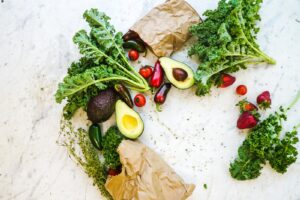I was walking through the market area in Charleston in May of 2019. As I was noticing the sweetgrass baskets, kitschy T-shirts, spice mixes, and beach treasures, I spied some bottles of extract. This was a brand that I had not often seen since childhood. There, among the many items of the market, were bottles of lemon extract. Seeing them took me back to the kitchen of my childhood home in Greensboro, North Carolina, some 45 years earlier, where that extract could be found on the spice rack.
“Hi Mom! Hi Nano! I’m home from school!” I yelled to my mother and grandmother as I opened the back door that Friday afternoon in 1975. The smell of lemon mixed with butter immediately hit my nose. Ahh, yes! There was a freshly-made pound cake that had just come out of the oven. Nano asked me whether I would like to remove it from the pan and I said, “Sure!” I turned the cake pan upside down onto the waiting rack and pushed the bottom of the two-part pan. The side of the pan slid up easily as a result of the massive amount of butter it was greased with. I then used a knife to lift the bottom part off. “Should I take off the waxed paper now, too?” I asked Nano. “Yes, of course”, she said. I peeled the paper off the cake and eagerly licked the crumbs. I could hardly wait until dessert that night to eat a piece of that moist, delicious cake with just a hint of lemon in it. That cake tasted like sunshine and love.
This was just the latest of countless pound cakes that Nano had made over the course of the previous 50 years. Her husband, Joe Usher, my grandfather (Papa), loved those cakes. So she made him one almost every week of their married life. He worked hard and long hours as the owner and head pharmacist of the Asheboro Street Drugstore and looked forward to that sweet dessert on the weekends. Sometimes she made pound cakes flavored with almond or the traditional vanilla. Other times she would use cocoa and make a chocolate pound cake. But Papa’s favorite was lemon, so that is what she made most often.
When Papa died in 1959, Nano stopped making pound cakes for a while. Then when we moved to Greensboro to live with her in 1963, she happily began making pound cakes again for her grandchildren, my brother and me.
It was April 1984, and I came into the door and began to hug Nano. “Yummy, it smells like lemon pound cake!” I exclaimed. “Yes, I knew you were coming by for a visit, so I made one especially for you.” Even though I was married and no longer living at home, I came by often because I worked in Greensboro. I told her that my husband and I would be moving to Aiken, South Carolina, at the end of the summer for his new job there. I was sad that I would not be seeing her on a regular basis anymore. She had been a literal second mother to me growing up — we had lived together since I was 5. Nano showed me her love in many tangible ways, including making pound cakes, buying me clothes, ironing my clothes, and giving lots of hugs.
One early morning in September 1989 I got a call from my mother. “Nano has passed away.” This call was not entirely unexpected, since Nano was 96 years old and had been mostly bed-ridden for the past 9 months. I cried anyway. After the funeral friends came to the house and, as at most funerals, there were all kinds of foods to eat. Someone brought a pound cake. This made me tear up a bit, because it was not Nano’s. I tried it, but it did not have the buttery taste or lemon that I remembered from hers. It was a bit dry and crumbly. But most of all it did not have Nano’s love in it.
When we walked by the market 2019 and I saw the lemon extract, I immediately thought of Nano’s pound cake. Even after 30 years I could still remember the smell and taste of it. Readers may ask whether I have the recipe for the cake and, if I do, why I don’t bake it myself. I did have the recipe, but since 2008 I have not been able to eat wheat flour due to my severe gluten sensitivity.
But it is OK. My hope and confidence rest in the Bible. “I thank my God in all my remembrance of you.” (Phil 1:3 ESV) Paul said this while he was in jail. He was remembering the believers in Philippi from the church he had started there. He would never again see them on earth, but he had supreme confidence that he would see them in heaven. Just as Paul had confidence that he would see the Philippians in heaven, I have confidence that I will see Nano one day in heaven.
I believe that one day all believers will live on the New Earth. Just as Jesus ate and drank in his resurrected body for the 40 days he was on earth, I look forward to that day when I can again eat lemon pound cake with Nano.






